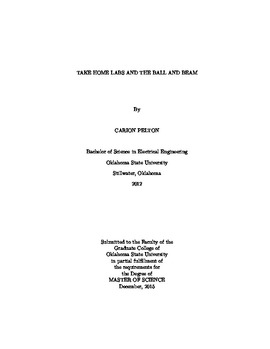| dc.description.abstract | The work in this thesis discusses the creation of affordable, simple, and high quality engineering laboratory experiments that can be done by students at home. The experiments will enhance the student's understanding of theoretical concepts within various engineering courses by providing a hands on learning experience. These experiments use MATLAB/Simulink in conjunction with an Arduino. The Arduino is an affordable open source microcontroller which has support within MATLAB/Simulink, thus allowing students to easily access the functionality of the Arduino without needing to have significant programming skills. Five experiments are created and presented, and for each experiment, additional hardware components are either purchased or 3-D printed. The first experiment is an introductory experiment for setting up the main hardware. The second experiment is another introductory experiment that uses a DC motor with encoder, a motor driver, and a 3-D printed load to help teach the concept of Sampling and data acquisition with the Arduino. The third and fourth experiments use essentially the same hardware as the Sampling and data acquisition experiment, and are created to help illustrate the importance of frequency response by performing the open loop and closed loop frequency response of the DC motor with an attached load. The final experiment helps teach the concept of optimal state feedback control of a Ball and Beam system. The experiments are provided as handouts to the be followed by the students. The handouts, hardware lists, software files, and 3-D printer files are provided on our website. The website makes the labs easily accessible to anyone interested, and keeps the experiments organized. The combination of the experiments, the hardware and software, using a 3-D printer, and the website results in an affordable, simple, and high quality lab kit with potential to be expanding into multiple engineering courses. Sean Hendrix and I jointly developed the Take Home Labs concept. | |
